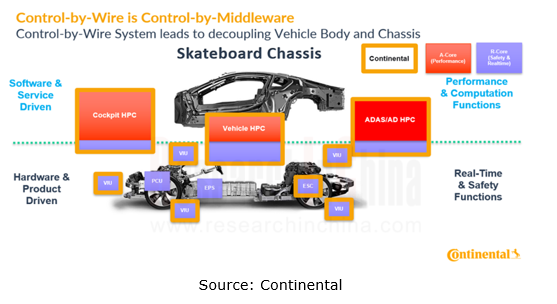Software-defined Vehicle Research Report, 2023-2024 - Industry Panorama and Strategy
1. How to build intelligent driving software-defined vehicle (SDV) architecture?
The autonomous driving intelligent platform can be roughly divided into four parts from the bottom up: hardware platform, system software (hardware abstraction layer + OS kernel + middleware), functional software (library components + middleware), and application algorithm software (autonomous driving, HMI, etc.).
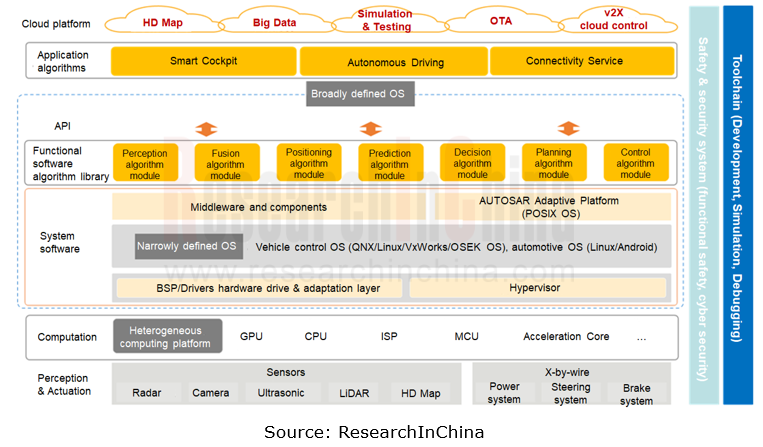
Autonomous driving R&D links mainly involve software engineering and hardware engineering:
 Basic software for intelligent driving: real-time vehicle control operating system (narrowly defined OS), intelligent driving middleware (ROS, CyberRT, DDS, AutoSAR), autonomous driving operating system (broadly defined OS), etc.;
Basic software for intelligent driving: real-time vehicle control operating system (narrowly defined OS), intelligent driving middleware (ROS, CyberRT, DDS, AutoSAR), autonomous driving operating system (broadly defined OS), etc.;
 General algorithm design for intelligent driving: positioning, perception, planning, decision, etc., covering from small models to foundation models (BEV Transformer, Occupancy Network, autonomous driving end-to-end neural network, etc.);
General algorithm design for intelligent driving: positioning, perception, planning, decision, etc., covering from small models to foundation models (BEV Transformer, Occupancy Network, autonomous driving end-to-end neural network, etc.);
 General algorithm training for intelligent driving: AI deep learning software platform, intelligent driving data training set, etc.;
General algorithm training for intelligent driving: AI deep learning software platform, intelligent driving data training set, etc.;
 Terminal-cloud integration for intelligent driving: data closed loop, data collection and labeling, simulation test (scene library, simulation platform), cloud native platform, HD map, etc.;
Terminal-cloud integration for intelligent driving: data closed loop, data collection and labeling, simulation test (scene library, simulation platform), cloud native platform, HD map, etc.;
 Intelligent driving system integration and engineering implementation: FCW, LDW, ALC, APA/AVP, etc.
Intelligent driving system integration and engineering implementation: FCW, LDW, ALC, APA/AVP, etc.
 Intelligent driving assistance software: ADAS performance evaluation, ADAS data recording, etc.
Intelligent driving assistance software: ADAS performance evaluation, ADAS data recording, etc.
 Intelligent driving hardware engineering: domain controllers (chips, hardware engineering), sensors (LiDAR, radar, ultrasonic radar, camera, GNSS, IMU, etc.), system engineering, chassis-by-wire, brake-by-wire, etc.;
Intelligent driving hardware engineering: domain controllers (chips, hardware engineering), sensors (LiDAR, radar, ultrasonic radar, camera, GNSS, IMU, etc.), system engineering, chassis-by-wire, brake-by-wire, etc.;
 Intelligent driving hardware system design: computing platform hardware system architecture design, vehicle chip system design, vehicle sensor system design, etc.
Intelligent driving hardware system design: computing platform hardware system architecture design, vehicle chip system design, vehicle sensor system design, etc.
There are usually two development paths for the kernel of intelligent driving operating systems:
One is to inherit the rich open-source ecosystems of Linux, based on the open-source and powerful Linux macro kernel, with a focus on enhancing its security and real-time performance and realizing the ASIL-B/D-compliant Safety Linux operating system. Linux operating system has rich ecosystems, but it is difficult to pass the required functional safety level certification;
The other is to emphasize functional safety, target ASIL-D functional safety level, and implement microkernel RTOS according to POSIX standards, such as QNX OS; compared with Linux, microkernel RTOS lacks the similar open-source ecosystem support and is difficult to develop.
Safety Linux originates from Linux and has rich hardware and software ecosystems. In the era of software-defined vehicles, Linux will boast a rising share in the autonomous driving market and become a dominant underlying operating system for intelligent driving. In China automakers and suppliers will also head in the direction of Safety Linux in development of intelligent driving operating systems.
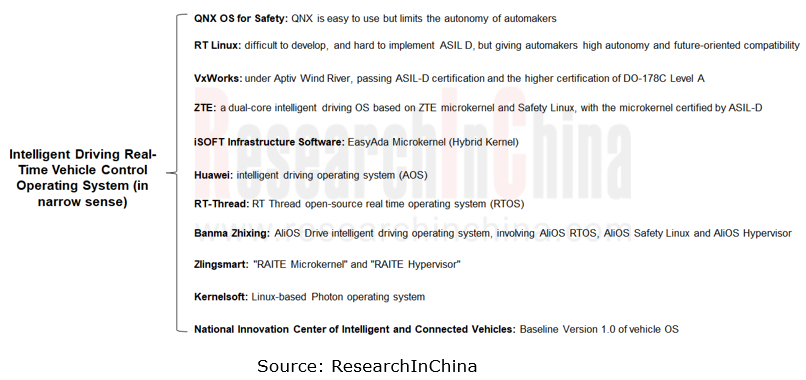
ZTE: The dual-core intelligent driving OS based on ZTE microkernel and Safety Linux takes into account the requirements of intelligent driving for functional safety and rich application ecosystems. It is composed of three parts: 1) ZTE Microkernel RTOS; 2) ZTE Hypervisor; 3) ZTE Safety Linux.
In terms of upper-layer software, ZTE has cooperated with middleware companies such as Neusoft Reach and iSOFT Infrastructure Software; as for bottom-layer chip, ZTE has established partnerships with mainstream Chinese chip companies like Horizon Robotics, Black Sesame Technologies, and SemiDrive.
In terms of mass production and implementation, early in 2021 ZTE had delivered a Safety Linux-based intelligent driving OS verification project to Changan Automobile. In 2022, ZTE and FAW started technical verification of intelligent driving OS based on microkernel + Safety Linux, and vehicle control OS. In 2023, ZTE added Dongfeng Safety Linux intelligent driving OS project.
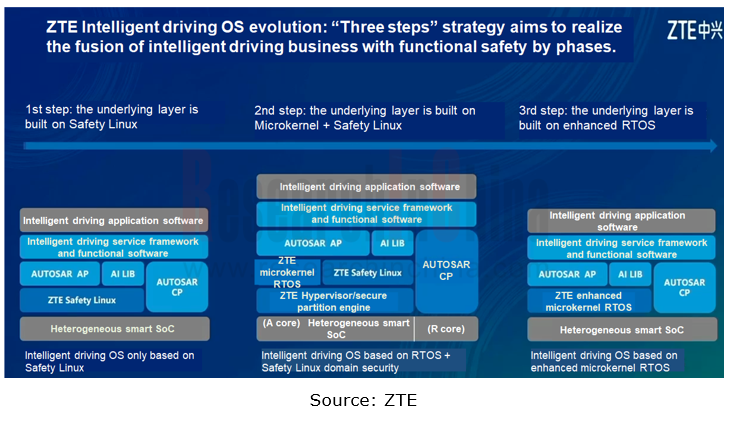
Banma AliOS Drive: It is a dual-core driver formed by AliOS RTOS and AliOS Safety Linux, with both security and performance advantages. Its basic system's security domain is AliOS RTOS, a self-developed secure real-time microkernel that meets the highest level of vehicle functional safety requirements, ASIL-D. It is composed of the following parts: 1) AliOS RTOS; 2) AliOS Safety Linux; 3) AliOS Hypervisor; 4) AliOS Drive Middleware.
As the performance domain, AliOS Safety Linux is based on Linux for real-time security enhancement and can support high-performance computing needs of autonomous driving. In addition, Banma's self-developed AliOS Hypervisor provides a good fusion mechanism for dual cores, and also meets ASIL-D, the highest vehicle functional safety level.
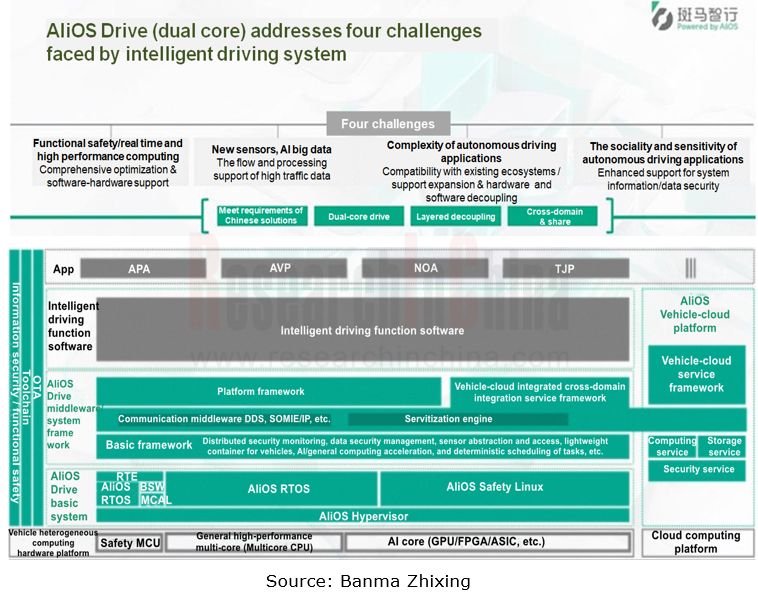
Intelligent driving operating system kernel: the key to breakthroughs in localization lies in the coordinated development of homemade chips and kernel OS.
At present, the ownership of automobiles in China has exceeded 300 million units, but the localization rate of vehicle operating systems (including intelligent cockpit system) is about 5-10%, and vehicle control operating systems (including autonomous driving system) are still in their infancy;
In addition to long development cycle, high technical difficulty, and heavy capital investment, the greater challenge is that "deeply binding" dominant underlying operating systems (e.g., QNX and Android) to core technologies (e.g., chips) has created a winner-take-all ecosystem. For example, Android and ARM has formed the "AA Alliance". The two don’t simply combine together, but work on deep customization for each other, triggering an ever-growing chemical reaction.
ZTE: In October 2023, ZTE and Black Sesame Technologies worked together to implement the first Chinese microkernel OS product based on Black Sesame A1000 to support the full business process of AI perception and reasoning, building a "Chinese chip" + " Chinese software" solution in the field of intelligent driving;
Banma Zhixing: Banma Zhixing has forged partnerships with more than 10 mainstream chip vendors. Based on AliOS Drive intelligent driving operating system, Banma Zhixing builds a computing base on Horizon Journey 5, a chip which can support stronger AI algorithm innovation;
iSOFT Infrastructure Software: In response to the China Automotive Operating System Open Source Program of China Association of Automotive Manufacturers (CAAM), iSOFT Infrastructure Software has built open-source co-construction cooperation with 21 units including FAW, BAIC Research Institute, Geely, Li Auto, SemiDrive, and Horizon Robotics. iSOFT Infrastructure Software has open-sourced the “龘” (EasyAda) microkernel source code to the industry, which has been first adapted to SemiDrive’s smart gateway SoC G9X;
Kernelsoft: The chip adaptation of Linux-based Photon RTOS now has supported such chips as NVIDIA Orin and Black Sesame A1000, and is being adapted to the chips of UNISOC, Rockchip, SemiDrive, etc. Kernelsoft plans to cooperate with more vendors like Horizon Robotics and Phytium. The BSP of the above-mentioned vehicle chips will also be open-sourced subsequently.
As for automakers, emerging carmakers with strong R&D capabilities will be more inclined to build a fully independent intelligent driving “underlying kernel + chip” system:
Tesla: Tesla has created its own RTOS (RT Linux, written in C language) based on the Linux system. On this basis, Tesla has built domain controllers, reconstructed automotive EEA, and applied self-developed FSD SoC;
Li Auto: deeply customized on Linux kernel, Li OS will be first installed on Li Auto’s all-electric models. It will also pack Li Auto’s self-developed intelligent driving SoC in the future;
NIO: SkyOS, a vehicle all-domain operating system based on Linux kernel, is the underlying operating system for NIO cars. It is installed on NT3.0 platform-based models (e.g., ET9) and is adapted to the chip platforms of NVIDIA, Qualcomm, Intel and others. In addition, it will also be equipped with Shenji NX9031, NIO's self-developed intelligent driving SoC.
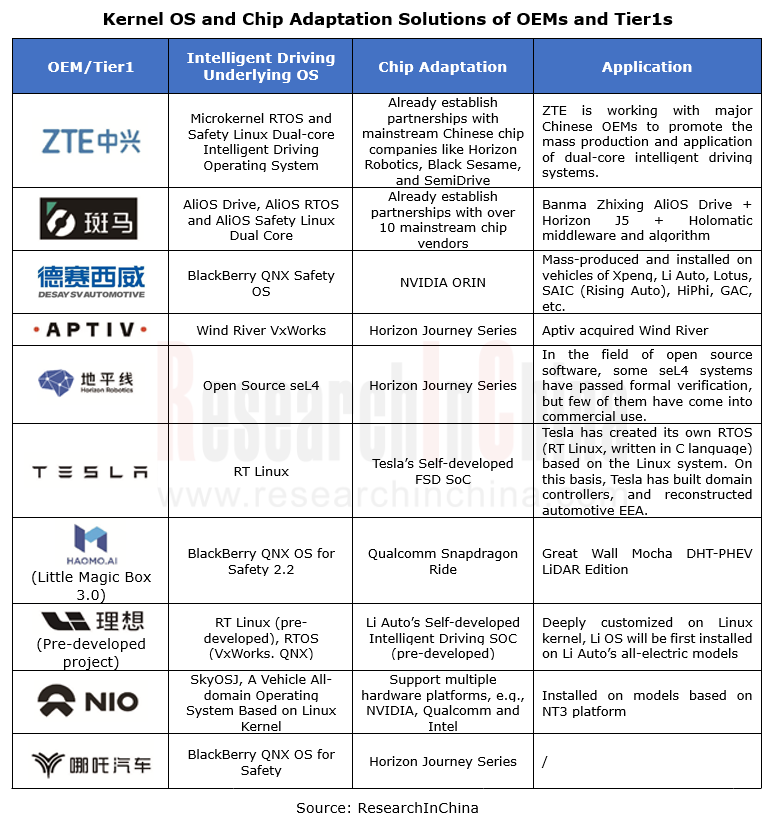
Chinese operating system providers have launched open source plans.
Currently, China is quickening its pace of developing open-source vehicle OS:
 In 2021, Huawei HarmonyOS was fully donated to the OpenAtom Foundationton to build the OpenHarmony open source project.
In 2021, Huawei HarmonyOS was fully donated to the OpenAtom Foundationton to build the OpenHarmony open source project.
 In 2022, Banma Zhixing announced that AliOS Drive will effectively enable layered decoupling, cross-domain sharing and open cooperation.
In 2022, Banma Zhixing announced that AliOS Drive will effectively enable layered decoupling, cross-domain sharing and open cooperation.
 In 2023, iSOFT Infrastructure Software joined China Automotive Operating System Open Source Program launched by CAAM. There are 21 member units including iSOFT, FAW, Dongfeng, Changan, CAIC, 32nd Research Institute of CETC, Shaanxi West Intelligent Connected New Energy Industry Group, Horizon Robotics, SemiDrive, Advanced Operating System Innovation Center (AOSIC) and University of Electronic Science and Technology of China (UESTC). In May 2023, iSOFT officially released the first microkernel open source project in China Automotive Operating System Open Source Program. It plans to launch the POSIX PSE51 OEM pre-research project and achieve functional verification in late 2023, implement functional safety verification in 2024, and realize mass production verification in 2025.
In 2023, iSOFT Infrastructure Software joined China Automotive Operating System Open Source Program launched by CAAM. There are 21 member units including iSOFT, FAW, Dongfeng, Changan, CAIC, 32nd Research Institute of CETC, Shaanxi West Intelligent Connected New Energy Industry Group, Horizon Robotics, SemiDrive, Advanced Operating System Innovation Center (AOSIC) and University of Electronic Science and Technology of China (UESTC). In May 2023, iSOFT officially released the first microkernel open source project in China Automotive Operating System Open Source Program. It plans to launch the POSIX PSE51 OEM pre-research project and achieve functional verification in late 2023, implement functional safety verification in 2024, and realize mass production verification in 2025.
 In February 2023, Kernelsoft announced the overall planning and open source plan about Photon OS. Photon Linux, which is used in intelligent vehicle cockpit domain and autonomous driving domain, will be open sourced as the starting point for implementation of Kernelsoft’s open source plan. Other relevant companies, institutions or developers can develop automotive OS and applications based on this open source version.
In February 2023, Kernelsoft announced the overall planning and open source plan about Photon OS. Photon Linux, which is used in intelligent vehicle cockpit domain and autonomous driving domain, will be open sourced as the starting point for implementation of Kernelsoft’s open source plan. Other relevant companies, institutions or developers can develop automotive OS and applications based on this open source version.
2. How to build intelligent cockpit architecture for software-defined vehicles (SDV)?
Intelligent cockpit R&D links mainly involve software engineering and hardware engineering:
 Cockpit basic software: vehicle operating system (QNX, Linux, Android, HarmonyOS, AliOS, etc.), virtual machine (Hypervisor), middleware (AutoSAR);
Cockpit basic software: vehicle operating system (QNX, Linux, Android, HarmonyOS, AliOS, etc.), virtual machine (Hypervisor), middleware (AutoSAR);
 Cockpit system software development: application development is mainly based on Android, cluster software development based on QNX, and TBOX software development based on Linux;
Cockpit system software development: application development is mainly based on Android, cluster software development based on QNX, and TBOX software development based on Linux;
 Cockpit interface design: UI design software;
Cockpit interface design: UI design software;
 Cockpit application software: user portrait, situational awareness, multimodal fusion interaction (AR HUD, voice, acoustics/audio, DMS/OMS, face recognition, gesture recognition and other software development). Foundation models have begun to be used in cockpit multimodal interaction;
Cockpit application software: user portrait, situational awareness, multimodal fusion interaction (AR HUD, voice, acoustics/audio, DMS/OMS, face recognition, gesture recognition and other software development). Foundation models have begun to be used in cockpit multimodal interaction;
 Cloud services: vehicle-cloud integrated platform, cloud native platform, information security, OTA development and operation strategy, etc.
Cloud services: vehicle-cloud integrated platform, cloud native platform, information security, OTA development and operation strategy, etc.
In terms of cloud-native platforms, leading OEMs and emerging carmakers take the lead. Automakers have begun to set up special digital transformation departments to accelerate the implementation of digital strategies and drive corporate innovation and change from the top.
Self-development: automakers pursue independent and controllable IT R&D and platform construction. Leading automakers have spontaneously chosen to self-develop. On the one hand, first-tier automakers boast great R&D and technical strength; on the other hand, they hope to ensure the stability and usability of their cloud-native platforms;
Open source: moreover automakers attach great importance to open source. Open source technology and community are the first stop for exploring cloud native. Open source is also the best way for automakers to pay attention to cutting-edge cloud native technology and foster technical talents;
Comprehensive digital transformation: in addition, cloud-native technologies such as container and microservice have also provided assistance to automakers to overtake on the bend in digital transformation. Building a cloud-native platform with full-stack capabilities has become the best way for advanced companies to realize digital transformation.
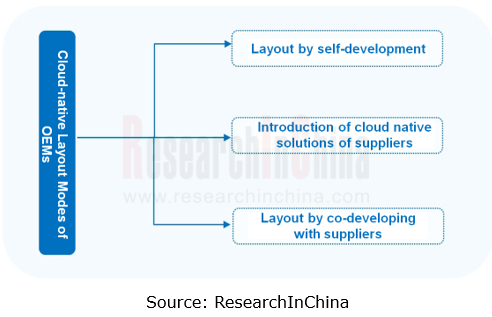
Cloud native originates from cloud computing, and is built and deployed in the cloud. It can truly access cloud infrastructures with powerful functions. Cloud native can be deployed in the cloud and inside the vehicle. Vehicle system software is becoming ever more complex, and the amount of code now has reached hundreds of millions of lines. Run-time software is therefore also introduced into the container inside the vehicle.
Geely: Geely's cloud-native technology was deeply co-developed with Volcengine and Neusoft Reach, a pioneer in broadly defined operating systems for software-defined vehicles and intelligent vehicles. At present, Geely has registered more than 30 patents for its self-developed digital twin intelligent cockpit system cloud application technology. Geely's cloud-native technology enables cloud-edge-terminal interconnection, decoupling of cockpit computing power and space hardware, and elimination of cockpit experiences’ dependence on the computing power of vehicle chips;
SAIC Motor Passenger Vehicle: CloudOS is mass-produced and used by SAIC Motor Passenger Vehicle. Based on cloud native technology, SAIC Motor Passenger Vehicle creates vehicle-cloud data cooperation architecture in which "data synchronization means functions work”;
Aptiv: Aptiv and Wind River co-developed an "end-to-end, cloud-native DevOps platform". In supporting software-defined vehicles, Wind River Studio can be divided into two parts: runtime software inside the vehicle and a Studio toolset in the cloud.
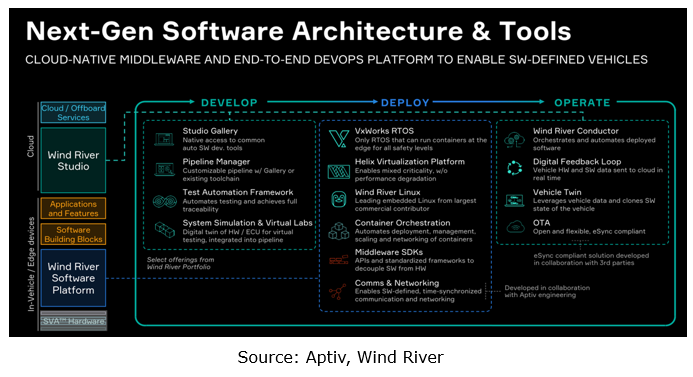
3. How to build intelligent vehicle control architecture for software-defined vehicles (SDV)?
Intelligent vehicle control specifically involves multiple subdivisions such as body control, chassis control, power control, and energy management. EEA further evolves towards cross-domain integration and "central computing + zone controllers" architecture.
The centralization of electrical architecture further integrates power domain, chassis domain and body domain to provide the integration of core control functions at the vehicle interlayer. Its goal is to create a vehicle control operating system for autonomous driving to be connected to vehicles. OEMs or Tier1s have different integration ideas according to their product features.
Lotus vehicle motion control unit (VMCU): based on the functions of VCU, it is expanded in the direction of chassis functions and integrates all vehicle-level control functions in the chassis domain, including TVC, ESP, and TCS. The actuators include “three-electric” controllers, and brake, steer and suspension in the chassis surround them and are controlled and coordinated by them uniformly.
Lotus is jointly developing VMC vehicle dynamic control software with different partners. The OEM focuses on its core competence, that is, differentiated development at the vehicle level, and works on some differentiated software and parameters of vehicles, allowing suppliers to concentrate on developing platform components.
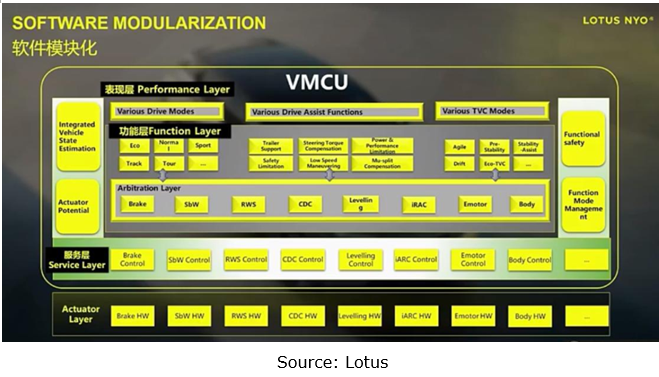
From functional domains to central computing architecture, the concept of zonal integration is indispensable, and the key link is the specific practice of zonal control. The new-generation body zone controller incorporates the idea of partial zonal control, divides the left and right controllers, and is responsible for signal collection and load drive in this zone. It has five core functions: zonal power supply, zonal information, zonal functions (provided by atomic services), zonal drive, and edge computing.
UAES USP 2.0 Developer Platform: in April 2023, UAES announced the USP 2.0 developer platform at its 2023 Developers Conference. USP2.0 enables the integration of nearly 20 independent ECUs via zonal architecture, with the communication rate increased from 2M to up to 1000M.
In the full process from development to testing and verification, UAES creates a pre-installed local development environment for developers and also provides a software development kit (SDK). On USP2.0, the services that can be called have gone deep into body control, energy management, motion control, thermal management and other fields.
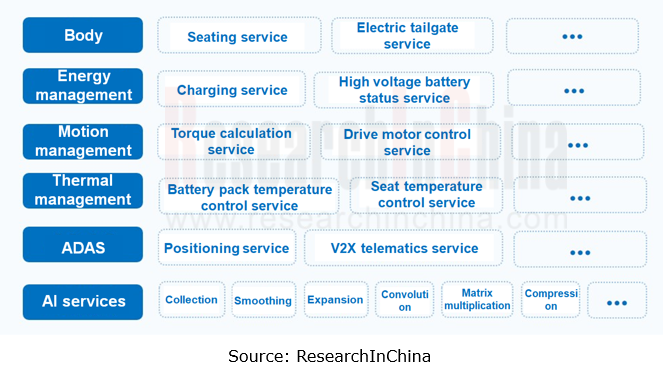
Continental's "Function as a Product (FaaP)" solution: suitable for all body and actuator functions and integrated into vehicle cross-domain products as a fast and cost-effective solution. For example, a variety of functions such as window lift, trunk control, seat adjustment, seat heating, and electric doors have the corresponding software package. Continental will expand them subsequently to bring more options.
The core of FaaP lies in decoupling of software and hardware. Continental's middleware can decouple the upper body and the lower body. It can be seen that the upper body highlights performance and computing power, involving ADAS algorithms and implementation of in-vehicle entertainment. The development of the upper body is more software and service oriented. The lower body is conventional body electronics and is hardware and product oriented.
The decoupling allows OEMs and Tier1s to develop with other suppliers and cooperate under the same framework, enabling higher development efficiency, and much higher portability of system modules.
